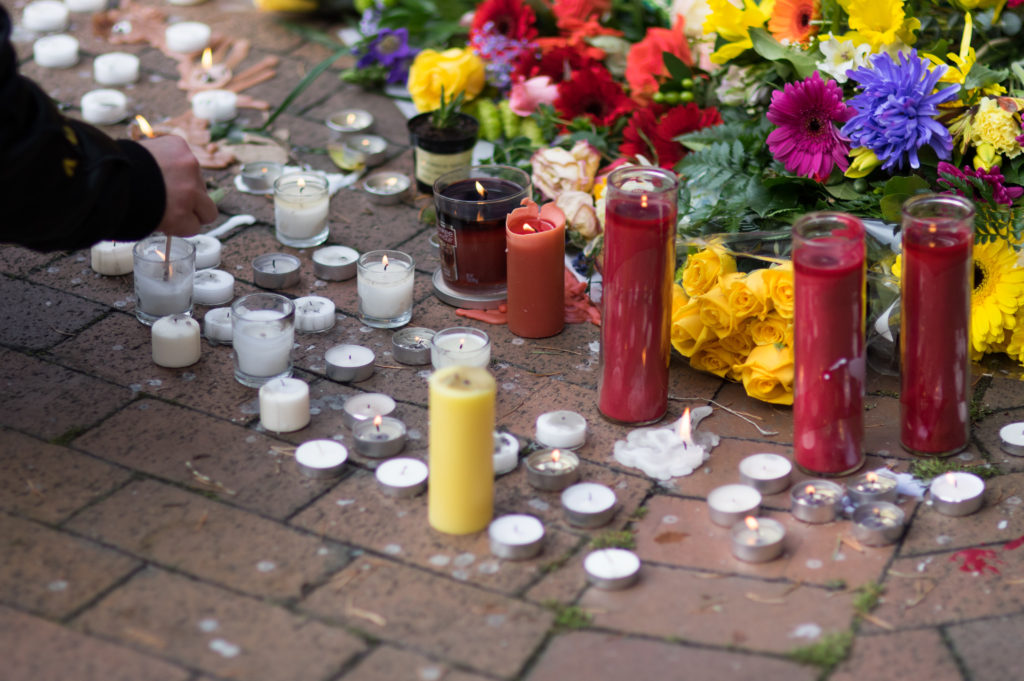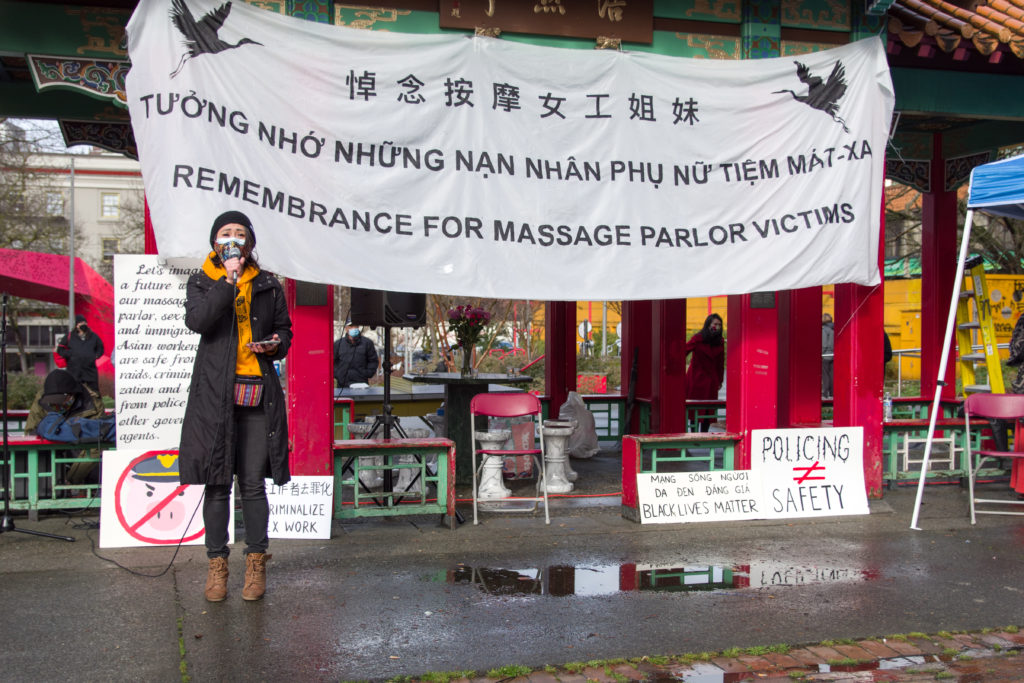By Wayne Au and Moé Yonamine

March 22, 2021, Seattle. Photo courtesy of Melissa Ponder.
Although the recent increase in anti-Asian attacks has been hard for all of us, the murderous killing spree in Atlanta has our families, our youth, and our communities spiraling. From a Japanese teacher in Seattle’s Chinatown-International District being assaulted by a man wielding a sock filled with rocks, to the robbery and killing of an Asian American elder in Oakland, to the elderly Asian American woman shoved and spit on in White Plains, New York, to the punching of an Asian man in North Portland, Oregon, these attacks both traumatize and activate us as Chinese American and Okinawan American educators personally. They connect us to our own experiences with hate in this country, and they highlight the deeply rooted history of white supremacy in violence against Asian people.
What is happening now is nothing new. The racism, the devaluing of life of Asian and Asian Americans, the dehumanizing of immigrant workers, the fetishism of — and violence toward — Asian women have been perpetuated throughout U.S. history. What’s more, the monolith that “Asians” are somehow one, single identity and image, invisibilizes the diverse racial and ethnic groups that our communities represent, and dehumanizes us both as individuals and as a collective. The white supremacist “model minority myth” has perpetuated a fake hierarchy, pitting people of color against each other for an unattainable proximity to whiteness.
As much of the country attempts to reflect and raise awareness, Asian and Asian American students from various states are choosing not to return to school, disproportionately absent from hybrid classes. The rise in hate crimes has resulted in fear for their own physical safety, both in and out of the school community. Students ask:
- Am I safe? Will I be next?
- Why hasn’t our community’s safety been a priority?
- Will anyone protect me from the violence?
- Do I matter?
To our Asian/Asian American students:
Please know that you are powerful and important. Your safety is an urgent right and we believe you. The weight of white supremacy is not your burden, although the activism you choose to lead in this moment will no doubt be invaluable for future generations. Resting is revolutionary. Turning off to take care of you is strong. So is demanding justice and organizing together on your terms. We will rise and we will collectivize across the nations. Asian Americans, you are beautiful.

To our Asian/Asian American teachers and educators:
Please know that we see you. We know that the trauma of the moment impacts you triply: Not only are you having to process your own emotional health right now, you are also potentially holding up your Asian American students, and you are also likely negotiating the complex issues of being forced to return to face-to-face schooling during the pandemic.
To our Asian family, who have resisted other movements for racial justice:
We ask you to hold onto this moment, this feeling. We ask you to remember it when we’re out in the streets yelling Black Lives Matter after the death of another Black person at the hands of the police; Remember it when you hear of the next ICE raid on undocumented workers or see immigrant children still kept in cages; Remember it when you hear about yet another missing or murdered Indigenous woman or see tribal nations fighting for sovereign control over their lands; Remember it when you hear about the targeting and profiling of the Muslim community, or the demands for climate justice from frontline Pasifika peoples. We ask you to remember this moment, this feeling, and understand that we are all linked through the oppression of white supremacy.
To our Black, Brown, Indigenous, and white educator family:
It is clear to us that in this moment, not only do many Asian Americans not know their own history, but a lot of folks in other communities do not know our history either. We don’t blame anyone, since we know how our country’s educational system works to support racism and Eurocentrism, and the sad fact is that we still have very little K–12 curriculum on Asian Americans. What we see and know is that this limited historical memory shapes — in bad ways — how folks make sense of, and respond to, the rise in anti-Asian violence.
As you learn or unlearn Asian American history, teach about the oppression from white supremacy, but also about the movements, activists, and solidarity across movements.
- Teach about the long history of violence against Asian Americans, and how ignoring that history is itself a form of violence.
- Teach about how pandemics have been used to justify anti-Asian violence.
- Teach how “Anti-Asian racism never stopped being an outgrowth of U.S. imperialism.”
- Teach about Asian Americans and important moments in People’s History.
- Teach the PBS Series “Asian Americans” and use the accompanying curriculum developed by Asian Americans Advancing Justice.
- Teach “A Different Asian American Timeline,” which places Asian American history in the context of race and capitalism in the United States.
- Teach about the incarceration of the Japanese Americans during WW II, from their imprisonment in local fairgrounds, to Japanese Latin Americans being rounded up internationally.
- Teach about the true diversity of Asians and Asian Americans, from Indigenous Okinawans who have been colonized and resisted colonization by both Japan and the United States, to Filipinos who have struggled against the imperialistic regimes of Spain and the United States.
- Teach that it is time to retire the term Asian Pacific American, because it marginalizes Indigenous Pasifika Island peoples.
- Teach about the murdered women in Atlanta: Soon Chung Park, Hyun Jung Grant, Suncha Kim, Yong Ae Yue, Xiaojie Tan, and Daoyou Feng, and say their names correctly using the Asian American Journalists Association pronunciation guide.
- Teach the “Hidden Stories that Give Rise to Violence Against Asian American Women.”
- Teach about the police killings of 20-year-old, Vietnamese American Tommy Le, 30-year-old Filipino American Angelo Quinto, and 19-year-old Chinese American Christian Hall, because it is important for both Asian and non-Asians to understand that, even though we do not face the same level of police violence as Black folks, even for Asian Americans, the police are not our friends.
- Teach about the murder of Vincent Chin, beaten to death by white laid-off autoworkers in Detroit, who blamed him for the rise of the Japanese car industry.
- Teach about the 1989 school shooting in Stockton, California, where a gunman opened fire on a schoolyard filled mainly with Asian American children, killing five and wounding more than 30.
- Teach about the 2012 white supremacist attack on a Sikh temple in Oak Creek, Wisconsin, in which six people were killed.
- Teach about the Asian American Movement, and the dynamic history of Asian American activism in the United States.
- Teach about the history of tensions and solidarity between Asian American and Black communities.
- Teach about the Third World Liberation Front, a multiracial coalition of Black, Native American, Latinx, and Asian American students in the San Francisco Bay Area who together, through protest, started the movement for Ethnic Studies.
- Teach about the Myth of the Model Minority as a form of anti-Asian racism and as a racist myth used as a “wedge” against other communities of color.
- Teach about Yuri Kochiyama, Grace Lee Boggs, and their solidarity work with the Black community.
- Teach about the Movement for Black Lives and the Black Lives Matter at School respective statements in solidarity with Asian Americans facing violence.
- Teach about early instances of interracial solidarity, like when Frederick Douglass spoke out against growing anti-Chinese violence in the United States and the movement for Chinese Exclusion.
- Teach about the organizing for Asian-Black solidarity happening in Oakland.
- Teach across K–12 using books by and about Asian Americans.
There is so much more to teach about Asian America, and we obviously don’t have enough curriculum. But this is a start.
As author Jeff Chang reminds us in the foreword to Karen Ishizuka’s Serve the People, “There was a time … when the term ‘Asian American’ was not merely a demographic category, but a fight you were picking with the world….”
It is a fight that requires solidarity — not just solidarity among Asian Americans, but with all communities battling for racial justice.
The time has come again to fight for Asian Americans and for Asian Americans to fight. In doing so, we need to remember that the enemy is white supremacy, the enemy is the myth of the model minority, the enemy is anti-Blackness, the enemy is imperialism, the enemy is settler colonialism, the enemy is environmental racism. It is a fight that requires solidarity — not just solidarity among Asian Americans, but with all communities battling for racial justice. It is a fight that requires us to teach and learn about each other, together, in struggle.
Wayne Au (Wayne.wk.au@gmail.com) is a Professor in the School of Educational Studies at University of Washington Bothell and is a long time Rethinking Schools editor.
Moé Yonamine teaches high school Ethnic Studies in Portland, Oregon. She is a Rethinking Schools editor.
